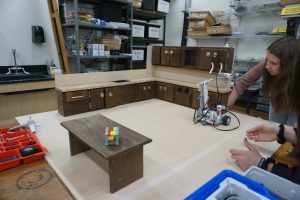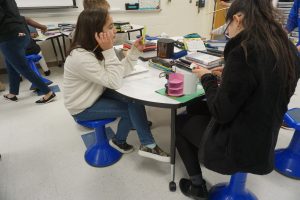Middle school students are learning about career paths in the skilled trades and K&B-related professions as part of the NKBA NextUp initiative. By Loren Kessell
The NKBA is working to generate awareness around the skilled labor shortage, and one of the best places to start is in schools.
As part of the NKBA NextUp program, Warren Hills Regional Middle School in Washington, N.J., received a $5,000 grant to make two programs a reality. These programs both focus on creating kitchen solutions, and illustrate the intersection of technology and robotics with design, building and practical applications in everyday life. The first-round winners will present their work during a school contest this spring.

In an eighth-grade class led by Larry Cascio, the STEM teacher, students are participating in the LEGO Mindstorm NKBA Design Challenge, where they’re tasked with creating LEGO robots that will need to perform various kitchen functions. They are utilizing the LEGO Mindstorms Education EV3 Core sets that include the EV3 Intelligent Brick, a programmable computer system that controls motors and collects data from sensors and program software. Students test their robots in a small kitchen replica Cascio built for the classroom.
“It’s great introducing students to real-life problem-solving in engineering challenges,” Cascio said. “When the students experience challenges, they learn to work through it.”
During the springtime contest, students will earn points for every task the robot completes in a timed competition. These tasks include turning a stove knob off and on, opening and closing a drawer, placing an object in the sink or on the counter, turning a light off and on, pulling out and pushing in a chair and placing an object in an upper cabinet.
Trial and error approaches are the only way to work through the tasks, and the students rotate constantly at the kitchen replica station. The groups work on different tasks at any given time.
“It’s been challenging to find the right design for the light-switch task,” student Kelly Molina said.
Her group had achieved the task of placing an object into the sink; their next challenge was perfecting a mechanism that can flip a light switch.
Another group is working on the function of turning an oven knob.
“We added a rotating mechanism with pieces that spin to move it,” added student Chris Smith.
By building robots to perform certain functions, students are learning valuable problem-solving skills and learning how to turn frustrations into innovations. They are exposed to applying sensor technology involving distance, touch and color sensors. Some are utilizing this technology in their robot builds.

The second contest, open to seventh and eighth graders at WHRMS is designing “The Kitchen of the Future.” Participating students develop a prototype device or other innovation that they envision will be critical in the kitchen going forward. They must focus on one component or device, and prepare materials including a blueprint, a working prototype, a log or written component detailing their brainstorming and development process and a tri-fold board presentation showcasing their design.
Jacqeuline Solecitto, the gifted and talented and interdisciplinary enrichment teacher, heads up this program and the middle school’s MakerSpace. Her enrichment students are participating in the contest, so they sometimes work on the projects during class. Currently, the class is developing its prototypes.
“We created a mechanism that raises and lowers a cabinet to help you reach it,” eighth-grader Donovan McHenry said.
For some, their projects are based on major life challenges and experiences. Seventh-grader Layla-Imani Wiggins is creating a kitchen that is accessible for someone with limited or no sight. Smart technology assesses the space and recites the contents of the room, and helps the person in need complete tasks. She dubbed her project “The Eye.”
“When I was born, I was blind, and now I have limited sight,” Wiggins said. “If a blind person needs something, they can ask ‘The Eye’ a question, and it scans to help them navigate toward it.”
A lot of the students use their experiences and personal flair to bring unique life to their projects. Solecitto encourages their creativity and enjoys seeing what they create.
“Seeing students’ enthusiasm for their ideas is inspiring,” Solecitto said. “Taking an idea and bringing it to life is challenging, and it’s great to see them feel respected.”
Robert Cacchio, assistant principal and technology education supervisor for the middle school, is overseeing the programs.
“We’re able to get these kids interested in coding, engineering and thinking outside the box,” Cacchio said. “The growth I’ve seen is amazing to watch.”
After preliminary judging, the winners of the first round will move to the big event on May 30. The NKBA will be on-site to judge the projects and declare the overall winners for both programs. Follow NKBA’s social media channels, and stay tuned for more updates.








